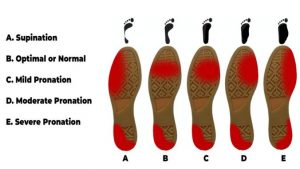What are the differences between pronation and supination on a practical level?

Supination vs. pronation is depicted in this diagram.
Dennis Homack, DC, MS, CCSP (Dennis Homack, DC, MS, CCSP) (Dennis Homack, DC, MS,
It’s incredibly uncommon for someone’s feet and stride to be completely balanced and weighted. Some people’s feet turn inward or outward overtly, while others have a more subtle inner or outside weight distribution.
Unless you look at the bottom of your shoes or get your feet scanned with the IDEASTEP or other scanning technologies, it’s difficult to notice.
Supination vs. Pronation
Supination occurs when the bodyweight is placed on the outside of the foot while walking or running. Pronation occurs when the weight is distributed more on the inner of the foot. Supination contains the word “up” in it, which makes it easier to distinguish and recall the difference. The foot should move from heel to toe in a correct stride, with a person’s bodyweight properly distributed on their feet, resulting in neutral pronation.
Supination causes uneven wear on the outside of the shoe, which reflects the stress of a person’s stride. Supination is associated with ankle pain and soreness, shin splints, and discomfort on the heels and balls of the feet, as well as calluses and bunions on the outside of the foot. Supination makes it easier for people’s ankles to roll outward while walking or running, resulting in more ankle twists and accidents.
Pronation, on the other hand, is significantly more common. Pronation is a natural occurrence that occurs when your feet roll inward while walking. When you overpronate, your feet roll in excessively, it becomes an issue. The arches of your feet flatten out as a result of this. Uneven wear on the inside part of a shoe’s sole indicates overpronation. Plantar fasciitis, knee, hip, and/or back discomfort are more common in people who overpronate.
Causes
While recognizing supination or pronation is simple, pinpointing the exact cause might be tricky. For starters, many people are born with one or both of their feet doing one or the other due to high or low arches or seemingly unequal legs (which could be due to hip alignment rather than actual length).
Injuries, on the other hand, might induce supination or pronation problems, especially if pain is neglected. When the body is in pain, it is a signal that something has to be done about it. Ignoring aches, twists, sprains, leg, hip, knee, or back pain will only make the issue worse. Rest is usually one of, but not the only, solutions to a problem. If someone already has knee or back discomfort, for example, their stride will most likely be altered to accommodate the pain, which can lead to overpronation.
A third factor to consider is one’s way of life. People who are on their feet for long periods of time may supinate or pronate in an attempt to find comfort and relief. Running can also produce problems, especially if someone trains at a fast enough speed to induce damage. It’s also possible that a person’s weight causes an uneven stride, particularly if they’ve recently gained or lost a lot of weight and their bodies are still adjusting.
Treatment
The good news is that supination or pronation can be easily treated, which can help to lessen long-term discomfort and injury risk. A fitted orthotic insole in shoes is the most efficient treatment for supination or pronation. However, keep in mind that this will need to be adjusted. Over-the-counter remedies will not provide the respite required to resolve the problem.
A fast foot scan is the initial step in treatment. IDEASTEP scanning technology is used by chiropractors and physical therapists across the country to scan a patient’s foot in less than two minutes and receive immediate findings. A foot scan determines how a person’s weight is distributed on their feet, which influences the design of their bespoke orthotic insoles. Following a scan, you can get customised insoles that will fit right into your shoes and provide immediate relief and better mobility.
The entire body, beginning with the feet, acquires equilibrium when wearing IDEASTEP custom orthotics. After a few months of employing orthotics, shoe wear should be more evenly distributed. Furthermore, when the body regains equilibrium and alignment, any discomfort produced by supination or pronation will fade away. IDEASTEP custom orthotics can considerably reduce, if not completely eliminate, lower back pain, knee pain, and an increased risk of ankle injury.
Hot blogs:
The Easiest Custom Insoles: Heat Moldable Insoles
Custom insoles, also known as orthotic insoles, are designed to provide personalized support and comfort for individuals with various foot conditions. In [...]
Children’s Insole Size Conversion Chart
The standard sizes for shoe insoles may vary from country to country, making it a headache to choose the right insole for [...]
Do custom orthotics need to be made by a doctor personally?
Custom orthotics do not necessarily need to be made by a doctor personally. While doctors, specifically podiatrists or orthopedic specialists, are often [...]
Do NBA players use custom insoles?
Custom insoles are not only helpful for people with foot health issues, but they also play a significant role in targeting the [...]
